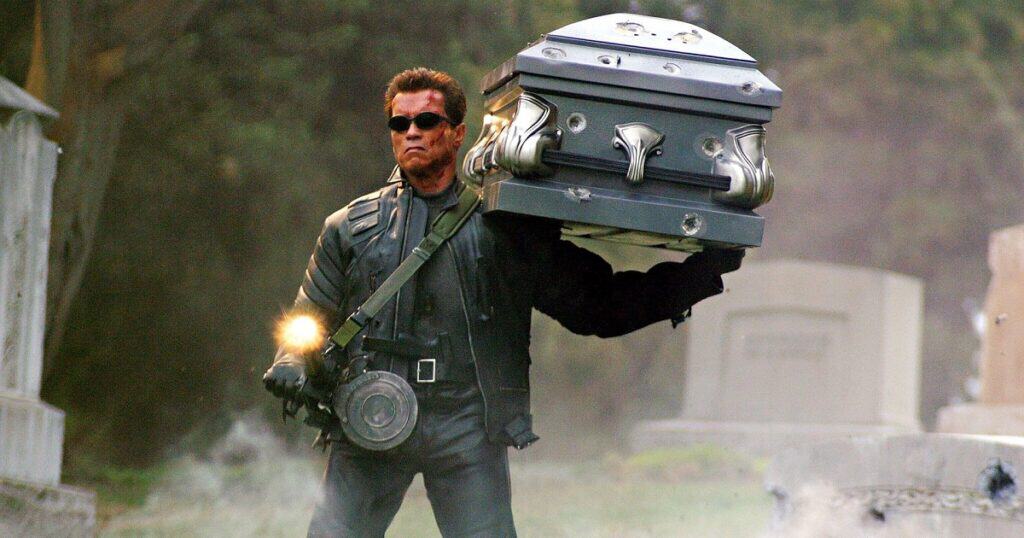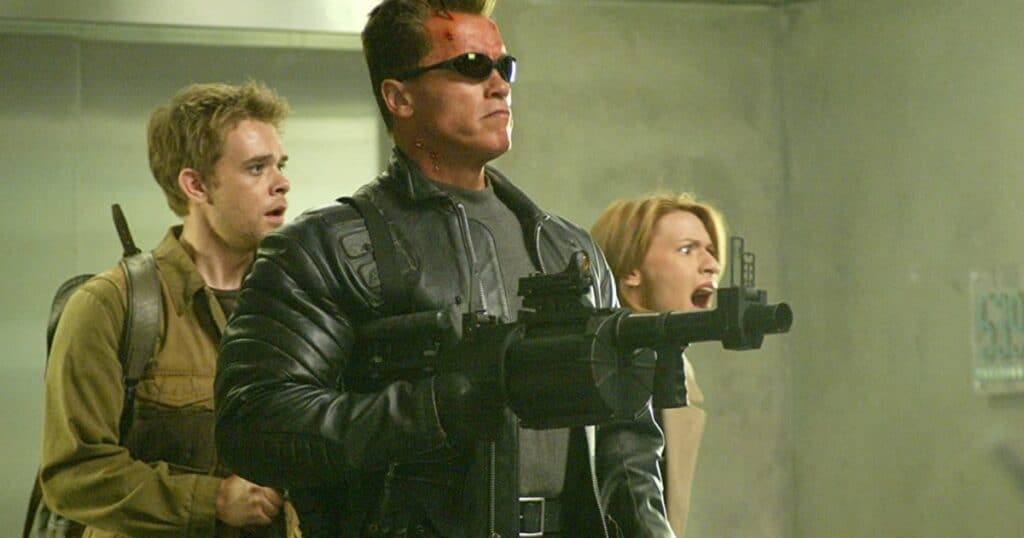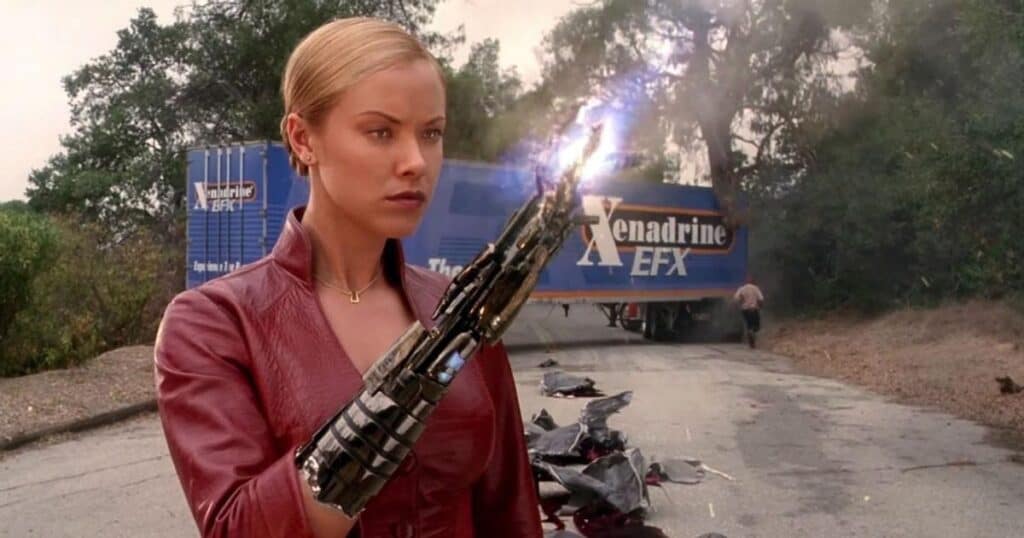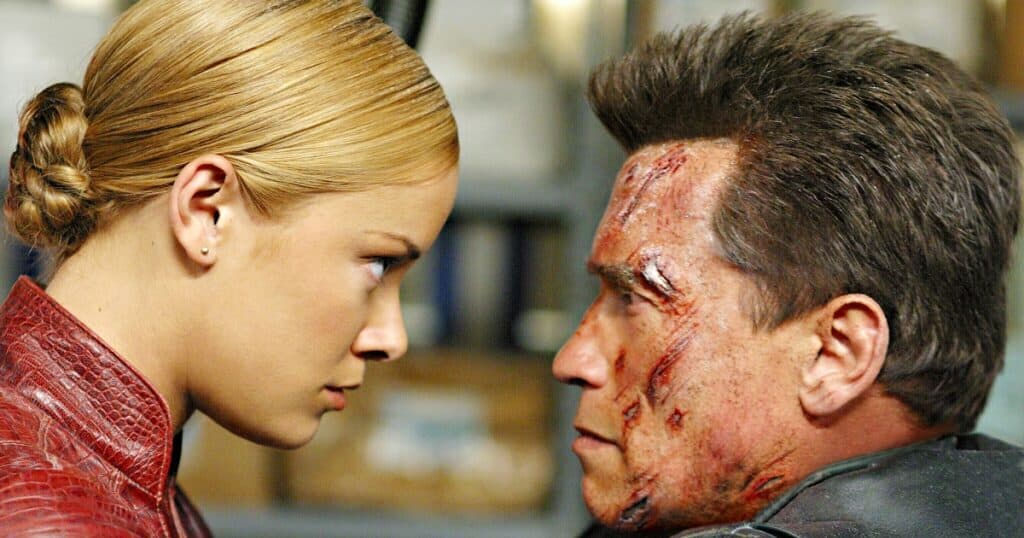
The episode of WTF Happened to This Horror Movie? covering Terminator 3: Rise of the Machines was Written by Mike Holtz, Narrated by Shawn Knippelberg, Edited by Joseph Wilson, Produced by Andrew Hatfield and John Fallon, and Executive Produced by Berge Garabedian.
Following the world-dominating success of Terminator 2 in 1991…we all knew what was coming. As Matthew Lillard’s Stu from Scream would say, “Let’s face it, baby….these days….YOU GOTTA HAVE A SEQUEL!”. But stop me if you’ve heard this one before, and a trigger warning alert for Friday the 13th fans…..before anything could be done, a tricky rights situation had to be sorted out. In this particular situation, the Terminator film rights belonged 50% to Carolco Pictures and 50% to James Cameron’s ex-wife Gale Anne Hurd. Rights she accrued in part when Cameron sold her his half of the Terminator estate for merely a dollar before the first Terminator film was made. Inflation is nuts! And so is the story of just WTF Happened to Terminator 3: Rise of the Machines.
Producers of the previous film, Carolco Pictures, would eventually declare bankruptcy and sell their assets in a liquidation auction. Which sounds like something cool Arnold would say to the T-1000 before blasting its liquids all over the place with a large weapon. That came out wrong. What I mean is, I could picture Arnold telling someone he’s about to “liquidate their assets” before blowing them to smithereens. Just…let’s move on…. 20th Century Fox was sure of their intention to purchase the rights to the sequels via a US bankruptcy court but there were still so many puzzle pieces yet to be put together, including the writer, director, and star. Cameron at this point was on record as uninterested in returning, saying they had made T2 in such a way the story came full circle and there needn’t be another.
According to Hurd, Schwarzenegger was always in play for a return…as long as he approved the script, director, and filming schedule. The chairman of Fox Film Entertainment at the time (well into 1997 at this point), Bill Mechanic wanted to secure agreements with the trio before officially picking up the rights to the sequels, knowing damn well that having this agreement in place would work in his favor with the courts in his effort to purchase the rights. Eventually, even James Cameron changed his mind, wanting to work with FOX on the sequel. None of it was to be.
One fateful night, Cameron invited his previous Carolco friends Mario Kassar and Andrew Vajna over for an early screening of Titanic, not knowing their friendship was headed towards its own iceberg. Cameron, as legend has it, would mention that the rights for Terminator were still available, as he and FOX were in the process of attempting to secure them. The pair would then go on to seek the rights themselves, hoping to begin a new production company with Terminator 3 as their lead horse out of the gate. Vajna didn’t see an issue with this perceived slight, since they would have wanted Cameron to direct anyway, as he did for them before. But it was all a moot point. When Mechanic then asked Cameron if he wanted FOX to outbid the pair for the rights, he had once again changed his mind during post-production on Titanic and no longer wished to direct. Although he did give a very loyal Arnold Schwarzenegger his blessings to make the movie with a new director, knowing how much he loved the franchise.
When the dust settled in 1998, after all the courts, bad blood, and even Dimension Films being in the running at one point….Kassar and Vajna had acquired not only the future Terminator film rights but also Hurd’s portion of ownership before signing her up as an Executive Producer. Terminator 3 officially had a home. But it was a home without any furniture.

The year is now 1999 and it was time to hire a writer for the follow-up to the greatest action movie ever made. Kassar and Vajna’s newfound production company, C2 Pictures, had a huge decision on their hands, and they decided to hire the writer of…..Tank Girl. You just….you do with that information what you want. Good for you Tedi Sarafian. Good for you. I’d have been shaking worse than Miles Dyson at the end of T2 holding that bomb.
Production company VCL was also brought on to have a 25% stake in the film and at one point Kassar had plans to shoot a third and fourth film back to back with two different directors. The writer of the second film? Jeff Speakman’s The Perfect Weapon writer David C. Wilson. We were truly all over the f*ckin (bleeped) map. The director wish list made a lot more sense and featured another round of trying to swoon Cameron, who declined a multitude of times for a variety of reasons, as well as notables David Fincher, Ridley Scott, John McTiernan, Roland Emmerich, and even Ang Lee. After all that, the job ended up in the hands of a game Jonathan Mostow, who had previously directed one of Kurt Russel’s most underrated films, Breakdown.
Mostow was quite clear however that he wanted Serafin’s script fixed to his liking before he’d agree to shoot. Enter new writers and frequent Mostow collaborators, John Brancato and Michael Farris, who had previously written David Fincher’s The Game and 1995’s Sandra Bullock vehicle, The Net. Ferris would also go on to write the Halle Berry Catwoman movie. Which I am mentioning for no other reason than to say you shouldn’t judge people by one piece of their work. Meow let’s move on.
Serafin’s original script featured John Connor working at a dotcom and a female villain who would turn invisible. An easy day for the Special Effects guys, sure, but not very fun for an audience. Who remembers the A Nightmare on Elm Street 4 invisible karate fight? Riveting. Much of Serafin’s script was gutted. One thing that remained was the villain being a female Terminator from the future. Whatever the case, the final script must have been great, because it garnered what was at the time the most expensive production budget in history at around 170 million dollars.
Part of all that cash was a record $30 million initial contract for the Austrian Oak, Arnold Schwarzenegger, which also included 20% of all of the film’s future profits. All this after his last few films, including Collateral Damage, The Sixth Day, and End of Days only grossed $142 million together (I still think two of those movies kicked ass though, Arnold). Sure, Arnold treated the studios like Suge Knight did Vanilla Ice, holding them over a balcony, knowing the leverage he held over the franchise; but being the total badass Schwarzenegger is, he also later gave up part of his salary so that the cast and crew could stay in Los Angeles and the entire crew wouldn’t have to have their set moved to the cheaper Vancouver, British Columbia area.

Arnold, as usual, had a lot going on at the time. While he had postponed some of his political plans once T3 finally got moving along, he was still flirting with the idea, even having politicians and journalists often visiting the set. Then there were the physical requirements of a 55-year-old man playing a physically perfected robot from the future. Arnold knew that if he fell off physically from the film, which at this point was over a decade in the rearview, he would be judged mightily. But he refused to be molded digitally, saying, “People would say, ‘He’s lost it; he’s all saggy and flabby,’ and that would be all anyone would talk about it. I didn’t want to be digitized, because someone would blab, and it would be in all the columns. So, I just worked harder.” Arnold had a twenty-foot trailer with a gym inside of it on set and would work out during lunch breaks and in between filming. And that’s why he’s Arnold Schwarzenegger…and why I ran out of breath making a sand castle yesterday.
FINALLY, after rights issues, bankruptcy courts, and even a writer’s strike pump-fake….Terminator 3 was set to appear butt naked, in an orb from the future, on the streets of California, to film in the year 2002. With Schwarzenegger on board, albeit without Cameron, it was time to round out the cast.
The obvious choice for John Connor was the return of T2’s Edward Furlong, who was at one point signed on for the role, then removed by the film’s US Distributor, Warner Brothers due to his ongoing public battles with substance abuse. The actor said, “It just wasn’t the time. I was going through my own thing at the point in my life…whatever…it just wasn’t meant to be.” Ironically, in the script for the finished movie, there are multiple drug and alcohol references related to John Connor, and one wonders if that wasn’t also on Warner Bros mind given his current public situation. Mostow would later say it was tough to cast this role because you had cast an actor in his twenties, who looked like he had the weight of the entire world on his shoulders. Possible actors to replace Furlong were Jake Gyllenhaal and Logan Marshall-Green…but history is history and Disturbing Behavior’s Nick Stahl would earn the role instead after a lengthy five auditions.
When director Jonathan Mostow originally signed on to direct the film, one of his main stipulations was that Linda Hamilton would return to play Sarah Connor. However, Hamilton declined, unimpressed with the script and absence of James Cameron, eventually stating “They offered me a part. I read it and I knew my character arc was so complete in the first two, and in the third one, it was a negligible character. She died halfway through and there was no time to mourn her. It was kind of disposable, so I said no thank you.” Which is understandable, and yes, I say that knowing Dark Fate happened. People’s lives change, man! I’m not judging. Ultimately, Mostow realized that she was right and that the film needed to focus on John, rather than regulating her to a third wheel. This led to John simply explaining that his mother had passed away from Leukemia before a wild and crazy shootout with Arnold carrying a casket on one shoulder Commando style.
The role of veterinarian and John Connor’s future wife and fellow Resistance leader Kate Brewster was initially cast in actress Sophia Bush, who played the role for an entire month before Mostow decided she was too youthful-looking and replaced her. That’s some Eric Stoltz Back to the Future type shit. Mostow then brought in his original choice for the role, Claire Danes, who had never done an action film before and gave it her all, although she might have thought she was in a horror film. Finally, we have the prized role of the future machine huntress that was so impressive (in more ways than one) that it supposedly made Arnold’s T-800 “obsolete” (his words, not mine!).
These next few sentences are going to be wild….

While Schwarzenegger campaigned for the Ninth Wonder of the World, WWF wrestler Chyna to play the role of the T-X, the studio auditioned over 10,000 women for the role. They at one point even changed their minds about the character entirely and considered casting Vin Diesel as the villain after the success of Fast and the Furious. Terminator 3 could have been very, very different. Like casting Eric Draven as a tatted-up mumble rapper for a Crow reboot kind of different. Yeah right, that would never happen! Finally, Kristanna Loken was cast, even beating out the great Famke Janssen for the role. Loken would put on fourteen pounds of muscle for the role and take mime classes to nail the robotic movements, impressing even Schwarzenegger. However you feel about T3, I think she was an ass-kicking stand-out for a lot of us in the film. And not that she was a total unknown or anything, but as Robert Patrick said about his casting as the T-1000 in Terminator 2, he worked as a villain for the audience in part because “they didn’t know who the hell I was!”.
By 2002, filming was set to begin on a script that would feature a major tonal change for the franchise; even including a moment where Arnold steals the clothes of a male stripper, including his pink star-framed sunglasses. On paper, I would have lit this script on fire and chased its writer down the studio hallways Ari Gold style. But to be honest, the scene was hilarious. There were multiple moments of great Arnold comedy in T3, just as there had been in T2.
John Connor’s story is still dark, and finds him on the run, unable to enjoy any semblance of a normal life. Skynet sends an advanced Terminator to kill both John and his future co-workers (the aforementioned T-X model), in the form of a beautiful woman who has new and seemingly unstoppable capabilities. Meanwhile, the resistance, in a last-ditch effort, has sent good ole’ outdated and overmatched T-800 Arnold to stop her. Now reprogrammed as the T-850.
Mostow knew exactly what he was doing making Arnold the underdog, stating, “It’s always great if you can have your protagonist or hero be completely outmatched.” He’s right, and it’s an important fabric of the entire Terminator franchise that even with some technical hiccups, Rise of the Machines handles well.
We get to watch the T-X go on a mini-slasher spree, even pulling the good ole’ Super Troopers “enhance” bit on her own chest to get out of a speeding ticket. This is all pure unbridled entertainment before we’re thrown back into John’s story where he meets up with Kate (the not-so-entertaining storyline) in a really weird scene involving a Vet’s office and a paint gun. Finally, everyone meets up, a royal rumble ensues and the “chase” element of the script begins as the two terminators tear through downtown Los Angeles in an entertaining melee that would have had the Police Chief from Last Action Hero with smoke rolling out of his ears again. The goal eventually becomes to reach Kate’s dad, US Air Force General Robert Brewster, played by David Andrews before he is unknowingly pressured into releasing Skynet in an attempt to kill a massive server virus. They don’t reach him in time and all Hell breaks loose, leading to a surprisingly somber ending with John and Kate in a bunker, receiving a transmission from an emergency radio, and becoming the leader of the resistance as the nuclear holocaust rages around them.

Rise of the Machines ended up being such a strange film. While it was never in the same league as its predecessors, it’s a strangely watchable and entertaining film, albeit with many flaws. Arnold was still Arnold, and the action scenes were ambitious. Even if they weren’t nearly as technically proficient and needle moving as what had come before.
One such scene, thought up by stunt coordinator Simon Crane involved a 14-camera one-take shot which sent Schwarzenegger (who did a lot of his own stunts) as the T-850 smashing through a glass building and firetruck. This led to Arnold spending days and weeks hanging from a crane and encountering many “close calls”. In the end, T3 would feature more than 600 special effects shots from Stan Winston’s Industrial Light & Magic company. Throw in Scream Composer Marcos Beltrami’s score and Terminator 3: Rise of the Machines was ready to unleash itself upon the Summer box office. Backed by a huge marketing plan that included a Superbowl spot, a Todd McFarlane-produced action figure line, and an Atari video game…..Terminator 3 was released on July 2nd, 2003. Twelve years after its predecessor changed action movies forever.
With a record-breaking budget of 187 million dollars, Terminator 3 needed a big box office……..and they got it. $44 million on its opening weekend on its way to a worldwide grab of $433 million. Warner Bros would go on to call the film “meaningly profitable”. How did the critics and audience take a Cameron-less third film in the beloved franchise? Surprisingly well, given the obvious quality drop-off (again, a drop-off from T2 is nothing to be ashamed of) and the large boots the film had to fill, most saw Terminator 3: Rise of The Machines as a flawed but fun ride. Audiences gave the film a B+ CinemaScore and to this day, the film sits with a 70% critics approval rating on the review aggregate Rotten Tomatoes.
Mostow had no illusions about his daunting and well-accomplished job here saying, “The problem in Terminator 3 is that Terminator 2 was such a seminal movie. It was going to be impossible to blow people away because T2 was the first time a lot of people saw digital effects. The liquid-metal man, no one had ever seen that before. That and Jurassic Park, those are two movies that probably most have blown people away from seeing them in the theater. I knew that we wouldn’t be able to achieve that.” Self-awareness is a big tool to have in your arsenal, folks. And because of it things all worked out in the end for Mostow and Company. The franchise stayed alive despite the absence of Cameron, who would go on to call the film “great”. More sequels would be made….but none of them feel quite like Terminator 3: Rise of the Machines; a strange but watchable and fun outlier in the Terminator universe. And that my friends, is WTF happened to Terminator 3D: Rise of the Machines.
A couple of the previous episodes of WTF Happened to This Horror Movie? can be seen below. To see more, head over to our JoBlo Horror Originals YouTube channel – and subscribe while you’re there!
The post Terminator 3: Rise of the Machines (2003) – WTF Happened to This Movie? appeared first on JoBlo.
Leave a Reply